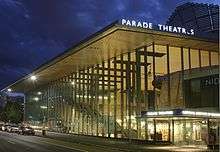National Institute of Dramatic Art
|
| |
| Established | 1958 |
|---|---|
| Location |
Kensington, New South Wales, Australia (Map
) 33°54′57″S 151°13′31″E / 33.9158°S 151.2252°ECoordinates: 33°54′57″S 151°13′31″E / 33.9158°S 151.2252°E |
| Campus | Urban |
| Website | nida.edu.au |
_logo.jpg) | |
The National Institute of Dramatic Art (NIDA) is an Australian national education and training institute for students in the performing arts. Since 1958, NIDA has educated students in performance and production for theatre, film and television. It offers programs ranging from degrees to public short courses, including holiday programs and corporate training.
In 2018, NIDA was ranked as the 10th best drama school in the world by The Hollywood Reporter.[1]
NIDA's main campus is based in the Sydney suburb of Kensington, located adjacent to the University of New South Wales, and is made up of a range of rehearsal and performance venues. NIDA is affiliated with the University of New South Wales.
NIDA receives funding from the Australian Government through the Minister for the Arts, Attorney-General's Department and is a member of the "Australian Roundtable for Arts Training Excellence (Arts8):"[2] an initiative between the national performing arts training organisations and the Australian Government providing training for emerging artists.
History


Founded in 1958, NIDA commenced acting classes in 1959. More than 50 years later, NIDA has grown to approximately 232 full-time students annually, approximately 70 full-time staff members.
Admission
Entry to NIDA's higher education courses is highly competitive, with approximately 5,000 applicants from around the country competing for an annual offering of approximately 75 places across undergraduate and graduate disciplines. The student body for these courses totalled 199 in 2014.
Campus
NIDA is located on Anzac Parade in the Sydney suburb of Kensington, across the road from the University of New South Wales. The campus was first opened in 1987, followed by additional buildings opened in 2001, which were awarded the 2002 Sir John Sulman Medal for public architecture.
Theatres
NIDA has five theatres.[3] The largest of these is the Parade Theatre offering seating for audiences of up to 707 people in its three-tiered, horseshoe-shaped auditorium. The Playhouse, Studio Theatre, the Space and the Atrium offer a variety of flexible performance spaces.
Library
The Rodney Seaborn Library is a specialist library for NIDA students, graduates and staff and is also open to the general public by appointment. Created in 1980.
The NIDA Archives collects, organises and preserves archival records created by or relating to NIDA.
Other facilities
The NIDA campus includes rehearsal rooms, multi-media and computer-aided design (CAD) studios, a sound stage, a lighting studio, production workshops, audio-visual facilities, and the Reg Grundy Studio film and television training and production facility.
Alumni
Graduates from the National Institute of Dramatic Art include:
Acting
- Cate Blanchett AC
- Grant Bowler
- Tom Burlinson
- Nathin Butler
- Alex Russell
- Toni Collette
- Essie Davis
- Judy Davis
- Andrea Demetriades
- Lewis Fitz-Gerald
- Colin Friels
- Mel Gibson
- Luke Hemsworth
- Remy Hii
- Matthew Le Nevez
- Glenda Linscott
- Baz Luhrmann
- Jessica Marais
- Catherine McClements
- Garry McDonald AO
- Jacqueline McKenzie
- Greg McLean
- Bianca Moon
- Toby Leonard Moore
- Robyn Nevin AM
- Matthew Newton
- Bojana Novakovic
- Miranda Otto
- Susie Porter
- Philip Quast
- Richard Roxburgh
- Toby Schmitz
- Hugh Sheridan
- Sarah Snook
- Yael Stone
- Vitas Varnas
- Hugo Weaving
- Sam Worthington
- Meyne Wyatt
- Anna Torv
- Zindzi Okenyo
Design
- Adrian Britnell
- Dale Ferguson
- Catherine Martin
- Ralph Myers, Former Artistic Director Belvoir St Theatre
- Michael Wilkinson, 2014 Academy Award Nominee for American Hustle
Directing
- Paul Curran
- Gale Edwards
- Jennifer Kent
- Dane Laffrey
- Tommy Murphy
- Kip Williams, artistic director of Sydney Theatre Company
Production
- Jim Sharman, Director of The Rocky Horror Picture Show
Controversy
In 2012, former NIDA board member and Liberal senator Chris Puplick, who had served on the board from 1994 to 2000[4] and 2007 to 2010,[5] wrote an essay titled "Changing Times at NIDA" which was published in the October issue of the publication Platform Papers. In the essay, Puplick criticised the teaching standards of the school and its director and chief executive, Lynne Williams, stating that she has had no significant experience in theatre to head the school and that her style was "Thatcherite".[6] Soon after Puplick's statements were reported, chairman of NIDA's board, Malcolm Long, and Lynne Williams replied back to the comments, with Long stating that Williams had the complete support of the board and described Puplick as "an apparently disaffected former board member." Williams had defended herself stating her management style was not "Thatcherite". Long also mentioned that amongst Williams' supporters were Cate Blanchett and Ralph Myers.[7] Supporting Puplick were actor, director and a graduate of the school Jeremy Sims, who had launched the essay,[8] and Kevin Jackson, who had taught acting at the school for 27 years.[7]
References
- ↑ "The Old Globe and University of San Diego - The 25 Best Drama Schools for an Acting Degree, Ranked". The Hollywood Reporter. Retrieved 2018-08-05.
- ↑ Department of the Environment, Water, Heritage and the Arts (15 September 2008). "Arts training bodies". Archived from the original on 21 August 2008. Retrieved 3 October 2008.
- ↑ https://www.nida.edu.au/venue-spaces
- ↑ Taylor, Andrew (19 September 2012). "New drama playing in the wings". The Sydney Morning Herald. Retrieved 8 February 2017.
- ↑ Eltham, Ben (21 September 2012). "NIDA dramatics ignore play on arts education". Crikey. Retrieved 5 January 2017.
- ↑ Taylor, Andrew (17 September 2012). "Drama at NIDA: former board member slams falling standards". The Sydney Morning Herald. Retrieved 5 January 2017.
- 1 2 Taylor, Andrew (19 September 2012). "Act II of NIDA drama as bosses hit back". The Sydney Morning Herald. Retrieved 5 January 2012.
- ↑ "The NIDA controversy". Radio National. 31 October 2012. Retrieved 5 January 2017.